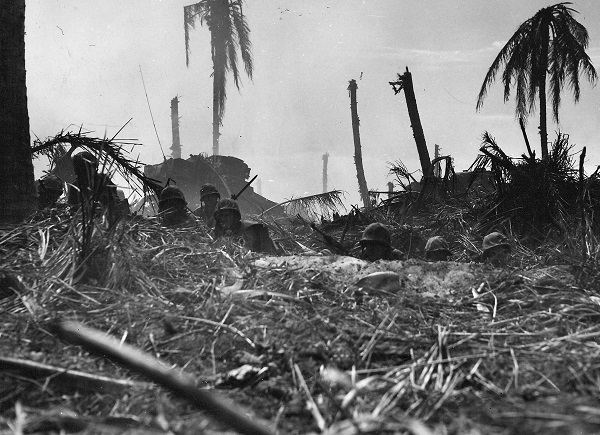Hear what World War II sounded like with this short list of historical audio clips available online.

Ever wonder what World War II sounded like? You can hear some of the sounds of the war in documentary film productions like Memphis Belle: The Story of a Flying Fortress. But if you put your mind to it, you can find many other sound recordings of the war online. We’ve done a little digging to give you a head start.
Link: Marine Combat at Namur
If you think the Library of Congress is an unparalleled repository of historical sound recordings, you’re right. The National Audio-Visual Conservation Center manages that vast collection. Few of the recordings available online feature actual sounds from the front lines. But one that does is the “earwitness” account of the US Marine Corps’s assault on Namur during the February 1944 Battle of the Marshall Islands. Sandwiched between a brief introduction and conclusion is a running descriptive recording made by a marine during the actual fighting. Sounds of machine guns, bazookas, tanks, artillery, and aircraft put you in the middle of the fighting, guided by a marine who remains calm and articulate despite the fact that enemy fire is coming his way.
Link: Tanks on Guam
Here’s an American tank crew working hard to take out enemy opposition during the invasion of Guam in July 1944. You can hear the urgency of their mission, their sharp focus on identifying targets, and the interaction that helps them sight Japanese positions and blast them. This recording is accompanied by interesting and relevant tank combat footage, though the audio and video don’t seem connected.
Link: Shipboard Sounds
Want to hear what general quarters sounded like on a US warship in the Second World War? Take in the sounds members of the Silent Service heard daily inside their submarines? Or listen in as a hunter-killer ship goes after a Japanese sub? That and much more are available on the Historic Naval Sound and Video page of the San Francisco Maritime National Park Association’s website. There are some post-WWII recordings there, too, but the wartime samples are many and fascinating.
Link: Navy AA at Normandy
Thanks to the gutsy war correspondents of the 1940s, Americans heard the sounds of war in radio news reports like this one from NBC’s George Hicks. He’s reporting from the deck of the troop transport USS Ancon (AGC-4), off the coast of Normandy’s Cotentin Peninsula on D-Day, June 6, 1944. While he’s speaking, Luftwaffe fighters come slicing down to attack the Allied ships, and the Ancon’s deck gunners open up on them with fierce machine-gun fire. And you hear it all.
Link: The Deathly Silence
The people of London and GIs in camps throughout the European theater knew the unmistakable sound of the buzz bomb, or doodlebug—officially, the V-1 flying bomb. German launch crews preset this self-propelled, motorized bomb to fly a specific distance before its engine cut out, sending the bomb plunging toward a target below. This recording lets you hear the “buzz” of a V-1’s engine—and the sudden silence that means it’s on its way down.
Link: Airborne Chariots
Although this is a collection of recordings of all sorts of WWII aircraft over Britain, the sounds that will give you chills are in the first section: a recording of a German air raid over London. The sickly wail of sirens, the roar of approaching planes, and the scream of dive bombers swooping in to drop their payloads will have you looking for a bomb shelter. You’ll have new appreciation for what it felt like to be on the receiving end of a WWII bomb mission.
Link: …And Happier Sounds
Just a reminder: the Allies won out over the Axis aggressors! Here’s a recording made in someone’s home back in August 1945, capturing live radio coverage of festivities in New York City and elsewhere in celebration of the Allied victory over Japan. That steady racket in the background is the sound of Americans letting off steam after an all-consuming four-year push to save the free world—a world where archives like these are available to the public.
• American marines stay low during their cautious but steady advance on Roi-Namur, in Kwajalein Atoll in the South Pacific’s Marshall Islands, in the first days of February 1944. You can hear recordings of the fighting there online. US MARINE CORPS PHOTO. LIBRARY OF CONGRESS


FOLLOW US »
